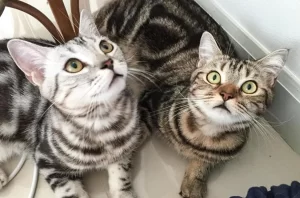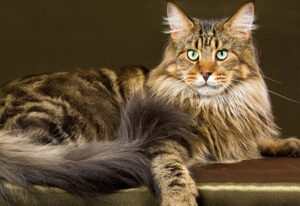
COAT CARE GUIDE FOR CATS
In this cat’s special, we have prepared a checklist for each individual coat type: long haired, short haired and hairless.
Cats, just like dogs, do need regular grooming and a question that is often asked is “Why bathe a cat when it cleans itself?” Well, that is precisely the reason for an occasional bath! When cats wash themselves by licking, they deposit saliva all over their fur which eventually does need to be washed off! As important as washing is a quick daily brushing regime for both Long and Short haired cats which I will explain in more detail under their individual headings.

Your cat should have a quick 5 minutes brush and comb every day to remove loose hair, so that when he grooms himself by licking his fur, he does not ingest lots of dead hair which can lead to furballs. Furballs are made when hair is swallowed and it congests in the gut to form a solid ball (or more usually sausage shape) and is eventually vomited up by your kitty!
This can be slightly alarming if you have not seen your cat do this before, so best prevent it if you are able to!
For your Short Haired Cat, the best tools to use are a rubber brush which will get rid of much of the loose hair and then a fine toothed cat comb to go over the coat and collect any remaining stray hairs.
Some cats tolerate being bathed very well and others absolutely hate it – you will soon find out which type of cat you have! However, our Purrfect Cat Shampoo which contains Catnip should help to make their bathing experience a good one or you can you our fragrance free PRO Cat Shampoo with Aloe Vera. Do ensure that the shampoo is rinsed off thoroughly and then pat your cat dry in a nice soft towel. You can use a hair dryer on a very low heat being careful not to blow directly into the ears or eyes.

It is absolutely imperative to keep up with the brushing and combing of your long haired cat, as mats and tangles are very quick to form and almost impossible to brush out. Five minutes of brushing each day will be far more beneficial then trying to tackle this coat once a week!
Brush the coat through with a slicker brush and then go over with a comb to make sure any tangles are banished. Long haired cats are even more prone to getting furballs in their stomach than their short haired brothers and sisters, so regular brushing will really help to prevent these forming.
For a video representation of How to Brush Your Short Haired Cat, check out our WildWash master groomer, Katie Rourke Dowding, showcasing these processes step-by-step:
For washing, you can follow the same directions as for Short Haired Cats but it is often advisable to apply our Super Sensitive Conditioner from our PET Range after the wash and comb it through before thoroughly rinsing.
WildWash have some great specialist cat products to clean ears and eyes and this should always be done before a bath. Our Daily Eye Cleanser for Cats can be used daily to keep your cat’s eyes free from secretions and the ‘dried up bits’ that accumulate in the inner corners. If you have a white or light coloured cat whose eyes are prone to tear staining, then our Tear Stain Remover for Cats will really help with this problem.
WildWash also has a special Paw Balm for Cats which is completely safe to lick and can be applied as often as needed.

These cats have very different grooming needs from cats with hair. Because of their physiology and excess production of oil, they do need to be bathed every week.
I do like to use our PRO Cat Shampoo on hairless cats as it is also great for cats with skin conditions and can be diluted before use to make it very cost effective.
When you wash your hairless cat, you will also need to gently exfoliate the skin using an exfoliating mitt or brush. This will keep the pores free of the sebum build up and help prevent blackheads.
Hairless cats often have a break-out of blackheads. Do try to resist the temptation to pop or squeeze these as this can cause infection. Gently exfoliate the area at every bath time and eventually they should clear up.
Hairless cats do need extra attention around the eyes as they have no eyelashes so gently clean the eye area with a cotton wool ball and some WildWash Daily Eye Cleanser for cats.
Have a look at our How To Clean Your Cat’s Eyes Guide for a better understanding.
Hairless cats are also unfortunately more prone to ear infections than their hairy sisters, so again do keep a check on this and clean the ears with our WildWash Gentle Ear Cleanser for cats before every bath.
Have a look at our How To Clean Your Cat’s Ears Guide for a better understanding.
Share this post with your friends and family

Join our email list to stay up-to-date about the latest products and offers, plus get
10% OFF
your first purchase.
By submitting, you agree to receive marketing emails for information on news, promotions, and offers from WildWash. For more details see our Terms & Conditions and Privacy Policy. You can unsubscribe at anytime.
